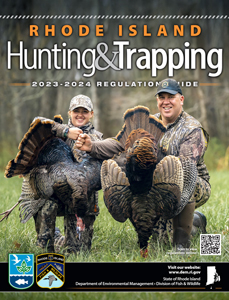Turkey Hunting
Wild Turkey
Dates |
Season Limit |
|
Fall Archery |
October 1 - 31 |
1 either sex bird |
Youth1 |
April 15 - 21, 2024 |
2 bearded birds2 |
Paraplegic1 |
April 20 - 21, 2024 |
|
Spring |
April 25 - May 19, 2024 |
|
General Rules and Regulations
- The hunting of wild turkey is permitted statewide. Check local ordinances for firearm discharge restrictions. Firearms are permitted for turkey hunting during the Spring, Youth, and Parapelegic seasons only.
- Spring season, including Youth and Paraplegic season shooting hours are one half (1/2) hour before sunrise to 1:00PM.
- Authorized firearms and archery equipment: methods of take are limited to shotguns, no larger than ten (10) gauges with shot sizes no larger than four (4), and by archery equipment except for crossbows. Long bow, re-curve bow, and compound bow must be set at not less than forty (40) pounds for archers using fixed blade broadheads, and a minimum of fifty (50) pounds for archers using mechanical broadheads. Only broadhead tipped arrows with at least two (2) metal cutting edges are allowed. All broadheads must be seven eighths (7/8) of an inch or greater at the widest point including mechanical broadheads measured in the “open” position.
- Hunters must carry a turkey-calling device (non-electric) while hunting.
- The use of decoys while hunting is allowed.
- Each year, after the end of the spring turkey season, online surveys are issued to Rhode Island turkey permit holders who have a valid email address within the online licensing system. The completion of this survey is vital to the turkey management program in Rhode Island and assists DEM biologists in maintaining a successful wild turkey season for our hunters. The Division requests your cooperation in filling out the survey, regardless of success or participation in that year’s hunt.
Permits and Tagging
- A hunter may purchase, possess and use one (1) all lands turkey permit and one (1) private land only turkey permit for the taking of one (1) bearded turkey on each permit during the spring seasons.
- Hunters may take two (2) turkeys on the same day or one (1) each on separate days provided they purchase two (2) spring turkey permits and at least one (1) turkey is taken on private land.
- A hunter may purchase, possess and use one (1) fall either sex archery permit, valid on both public and private property.
- A person killing a wild turkey must immediately notch the month, day, hour of kill and type of property taken on (private or public). The carcass and notched tag must remain in the possession of the hunter after the kill and while removing the carcass from the field. Should the hunter leave the carcass prior to removal from the field, the notched tag must be attached to and remain with the carcass. After removal from the field, the notched tag must be attached to and remain with the carcass until prepared for consumption or taxidermy.
Prohibited
- The use of any unauthorized firearm, live decoy(s), dog(s), baiting, cooperative drive(s).
- The use of crossbows for turkey hunting.
- Electric calling devices, or any other devices, to capture or ensnare turkeys.
- The shooting of turkeys while roosting.
- Stalking or attempting to sneak up on a turkey to get a shot.
- The hunting, killing, taking, or attempting to take or possess, any wild turkey by any individual unless they possess a permit to do so. However, a person having a valid Rhode Island hunting license may call turkeys for individuals with a valid turkey permit.
- Possession of more than one firearm or archery implement while turkey hunting.
- Possession of a firearm while hunting for wild turkey during the fall archery season.
Reporting Your Harvest
The killing of a wild turkey must be reported to DEM using the online harvest reporting website rio.ri.gov by 11:59 p.m. on the date of the kill. The notched tag with harvest report confirmation number must remain attached to the carcass until prepared for consumption or taxidermy.
Safe Turkey Hunting Is No Accident!
When compared to other sports activities (baseball, basketball and swimming--injuries per hundred thousand participants) hunting is a relatively safe activity. These comparisons should not cause any hunter to take accident-free hunting for granted. Each and every hunter must make safety the top priority of the hunt.
Turkey Hunting Safety
- NEVER crowd another hunter working a bird and avoid high-pressure areas.
- “Mistaken for game” accounts for 87% of all turkey hunting accidents — Be sure of your target and what’s beyond.
- Use proper setup techniques — Sit against a wide tree to shield head, neck and back. A tree is an effective blind as it breaks your outline.
- Never wear the colors red, white or blue while turkey hunting. These colors mimic the colors of a male turkey’s (gobbler’s) head and can draw fire. Be totally camouflaged.
- Never stalk turkey sounds or turkeys — it’s unsafe and illegal. Never use the sounds of a turkey to warn approaching hunters.
- Avoid using gobbling calls — which draw more hunters than game.
How to Tell the Sex & Age of a Turkey
Determination of the sex and age of a wild turkey is vital to the hunter, since only bearded wild turkeys are “legal birds” in the spring season. Proper identification of your target before shooting protects vulnerable hen turkeys from accidental shooting during the spring nesting season. The composition of the harvest provides biologists with information about the flock and is important for making conservation and management decisions.

